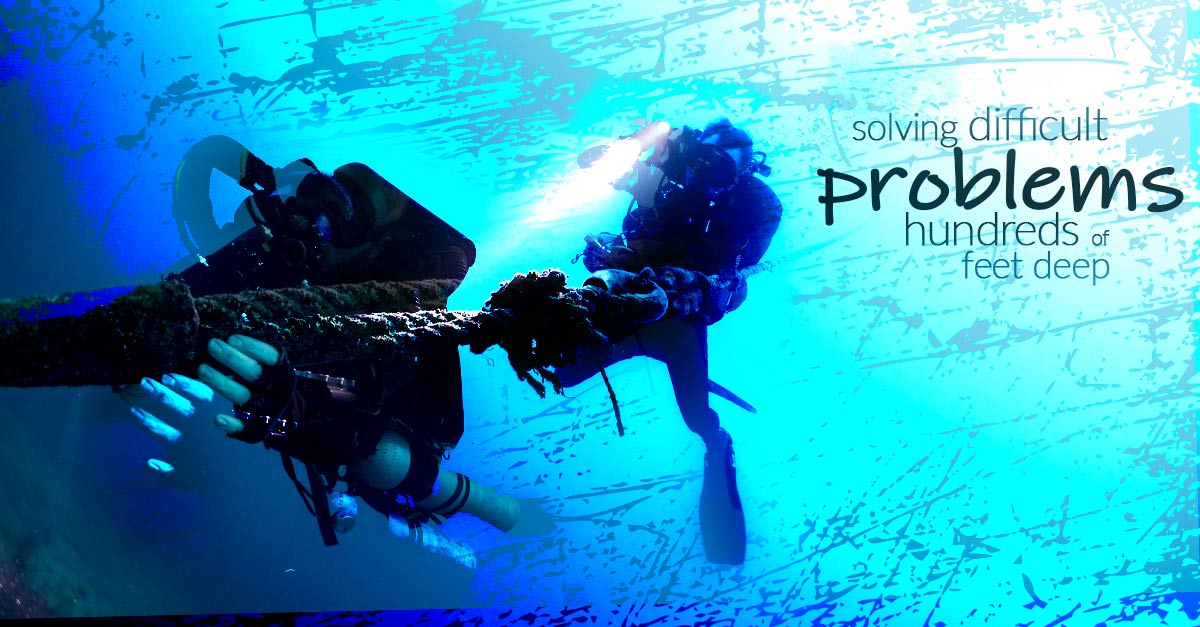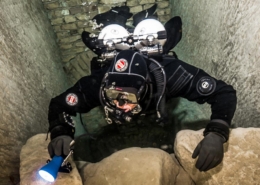Solving Difficult Problems far Below the Surface
By Jon Kieren
You are 100 m/330 ft under the surface. You hear a massive rush of bubbles behind your head. This can play out one of two ways.
- One way begins with you signaling your teammate and maintaining position in the water column. You reach back to close what you believe is the affected post. Together with your teammate, you identify and isolate the failure. You clearly communicate the problem within the team. Everyone knows what resources have been affected (gas supply, wing/drysuit inflation, etc.). You end the dive and begin to ascend.
- The other way? That s when things don’t work out as well.
When things don’t go quite as well
When the failure occurs, your stability is rattled.
- While reaching back to close the affected post, you turn away from your team. In so doing you lose reference of your position in the water.
- As you struggle to close the valve, you become increasingly stressed. CO2 begins to build up in your bloodstream as your heart and breathing rates increase.
- As tunnel vision sets in, your buoyancy begins to shift from the change in your breathing pattern. Due to your subconscious and erratic finning, you begin to ascend. You are so focused on closing the valve that you don’t realize you are ascending.
- When you finally realize you are ascending, stress increases and panic sets in. You no longer have the capacity to rationalize the situation.
- Instead of focusing on the buoyancy shift and managing the ascent, you continue to try to close the valve. Your ascent becomes rapid and uncontrollable.
By the time you hit the surface, you’re dead.
This situation can occur under a wide variety of circumstances
Minor errors or failures can quickly cascade into real emergencies. This is true whether you are on a shipwreck in deep open water, far back in a cave or even on a shallow reef.
When we look at diving accidents and incidents, it is almost never an equipment failure that is the end cause of a fatality. Such failures are usually several steps down the error chain as things cascade from an inconvenience to an unsurvivable situation.
We often chalk these accidents up as human error. We think, “Well, that was stupid. That’s not how I would have reacted. I would have been able to control my buoyancy. I’m awesome”.
The “Incident Pit” Concept
At the 1973 British Sub Aqua Club Diving Officers Conference, E John Towse introduced the Incident Pit concept. This concept essentially explains that as problems arise and are not managed properly, they become more difficult to manage.
We slide deeper into this pit, eventually unable to extract ourselves or teammate from the situation and it becomes unsurvivable. This concept is easy to visualize, but many of us often miss where the true failure lies: Stability in the water.
As a dive progresses, we operate on the first level of the incident pit. We manage normal situations such as communication, buoyancy changes, navigational decisions, etc. with relative ease.
But what we often don’t realize is that, in conjunction with a high level of attention being placed on our buoyancy and stability, our capacity to handle more complex tasks like equipment failures is limited. So when a problem does arise, it is the foundational skills that fail first as we become fixated on resolving what appears to be the priority.
When our stability fails, that’s when we quickly slide deep into the incident pit. Visibility is trashed due to making contact with the bottom. We get swept off the wreck or ascent line in the current, or we make and uncontrolled ascent. Now, a minor issue creates an emergency.
So how do we resolve problems in extreme environments?
Start with a solid foundation. Practice until you can handle basic tasks such as valve drills and S-drills until you can do so while maintaining a precise position in the water. Be able to do this without sculling, finning or needing to focus on buoyancy and trim.
Breathe appropriate gases that reduce equivalent narcotic depths and gas densities. At this point, you will be able to reserve the capacity to stop and think rationally through problems that arise. You will be able to assess your situation, evaluate what resources are available and take decisive action that will resolve any issues.
Most of the time, you’ll probably be fine. However, problems do arise on dives. It is the nature of the sport. Failure to place emphasis on maintaining a solid foundational skill set is setting yourself up for failure to manage these situations. It is your responsibility as a diver, as well as a teammate to keep these skills proficient.









 Natalie L. Gibb
Natalie L. Gibb
השאירו תגובה
רוצה להצטרף לדיון?תרגישו חופשי לתרום!